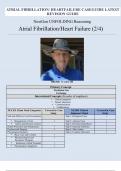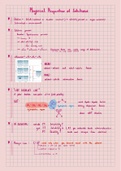-
1. Exam (elaborations) - Nurs 612 maryville exam 2 with correct answers latest edition
-
2. Exam (elaborations) - Certified medication aide review already solved 100% correct
-
3. Exam (elaborations) - Cnim practice questions with correct answers 100% guaranteed pass
-
4. Exam (elaborations) - Nurs ati teas test practice mathematics latest update 2023/2024 guaranteed success ra...
-
5. Exam (elaborations) - Ati rn vati comprehensive predictor 2019 form a b an c with correct answers
-
6. Exam (elaborations) - Leading and managing in nursing 7th edition yoder-wise test bank chapter 7 to 30 with...
-
7. Exam (elaborations) - Rasmussen mental health exam- questions and answers 100% correct 2024/2025
-
8. Exam (elaborations) - Nr509 week 5 quiz/88 questions and answers/100% correct
-
9. Exam (elaborations) - Nur 265 exam 3 87 questions and answers a+ graded 2024/2025
-
10. Exam (elaborations) - Hrb-27 final exam review with answers latest edition 2024/2025
-
11. Exam (elaborations) - Nrnp 6645 midterm, nrnp 6645 midterm quizlet, nrnp 6645 midterm exam, nrnp 6645 final...
-
12. Exam (elaborations) - Pharmacotherapeutics for advanced practice nurse prescribers, 5th edition woo robinso...
-
13. Exam (elaborations) - Microbiology final exam completed 2023/2024 100% guaranteed pass
-
14. Exam (elaborations) - apea 3p exam prep- gi questions with correct answers and explanations
-
15. Exam (elaborations) - Apea 3p exam prep - health promotion questions with correct answers and explanations
-
16. Exam (elaborations) - Ob fisdap exam questions and answers latest update 2023/2024 100% guaranteed pass
-
17. Exam (elaborations) - Wgu d033 end of chapter question and answers.
-
18. Exam (elaborations) - Wgu d033 study questions with complete solutions
-
19. Exam (elaborations) - Wgu d033 glossary terms with answers 2024/2025 100% guaranteed pass
-
20. Exam (elaborations) - Wgu d033 exam already graded a+ 2024/2025 100% guaranteed pass
-
21. Exam (elaborations) - Certified medication aide practice exam| 225 questions| graded a
-
22. Exam (elaborations) - Hesi ob maternity version 1 (v1) exit exam questions and answers (all 55 qs) a++
-
23. Exam (elaborations) - nclex rn exam questions and answers attained grade a+ assured satisfaction latest 20...
-
24. Exam (elaborations) - Wgu c215 aorn periop 101 final exam q&a (real) new update 2023/2024
-
25. Exam (elaborations) - &tab;rnsg 1343 med surg comprehensive exam 2 questions and answers rated a+ guaranteed sa...
-
26. Exam (elaborations) - Mega socra ccrp exam content| 790 questions (100 pages)| with complete solution
-
27. Exam (elaborations) - Test bank for leading and managing in nursing 7th edition by yoder wise (chapters 1-...
-
28. Exam (elaborations) - 2023 hesi pediatric (peds) rn actual exit exam: v1 & v2 questions and answer 100%corr...
-
29. Case - Nurs 6521 advanced pharmacology case; patient’s health needs
-
30. Exam (elaborations) - Nurs 211l ati peds proctored exam 100% ati pediatrics proctored exam
-
31. Other - Nsg 6020 final study guide exam questions and answers best graded a+ guaranteed succe...
-
32. Exam (elaborations) - Nurs 6541 midterm exam 6 – question and answers 100% guaranteed pass
-
33. Case - Case study: mn553 advanced pharmacology unit 9 case study|&opencurlydoublequote;prescribed drugs with ca...
-
34. Exam (elaborations) - Shadow_health_focused_exam_cognition
-
35. Exam (elaborations) - Nurs 6501 week 3 quiz (2023/2024): advanced pathophysiology -walden
-
36. Exam (elaborations) - Atrial fibrillation/ heartfailure caseguide latest revision guide nextgen unfolding r...
-
37. Exam (elaborations) - Roach's introductory clinical pharmacology 11th edition testbank with correct answers
-
38. Exam (elaborations) - Prophecy core mandatory part i,ii & iii exam 2023 graded a
-
39. Exam (elaborations) - Nsg 6020 midterm exam latest 2023/2024 already graded a+ health assessment south univ...
-
40. Exam (elaborations) - Hesi cat exam 2023 | hesi computerized adaptive testing (cat) test bank with rational...
-
41. Exam (elaborations) - Ati rn medical surgical proctored exam q & as latest update 2023/2024 verified answer...
-
42. Exam (elaborations) - Nur 2063 / nur2063 exam 1: essentials of pathophysiology exam 1 review (latest 2023/2...
-
43. Exam (elaborations) - Epidemiology assignment-question and answer latest update 2024/2025
-
44. Exam (elaborations) - ati rn comprehensive predictor exam with solutions latest update (2024/2025) ...
-
45. Exam (elaborations) - Nrnp/nurs 6645 final exam with correct answers latest edition
-
46. Exam (elaborations) - Lpn to rn transitions 4th edition test bank questions & answers latest edition
-
47. Exam (elaborations) - Ati med surg fluids and electrolyte balance and disturbances exam with 100% correct a...
-
48. Exam (elaborations) - Nr 509 advanced physical assessment-chamberlain college of nursing shadow health focu...
-
49. Exam (elaborations) - Advanced assessment interpreting findings and formulating differential diagnoses 4th ...
-
50. Exam (elaborations) - Nr 509 week 1 quiz with correct answers 100% guaranteed pass
-
51. Exam (elaborations) - Nr 509 week 2 quiz with correct answers 2024/2025 100% guaranteed pass
-
52. Exam (elaborations) - Nr 509 week 3 quiz with correct answers
-
53. Exam (elaborations) - Nr 509 week 4 quiz with correct answers
-
54. Exam (elaborations) - Ati pn pharmacology proctored exam 2020 (updated 2024/2025) 100% guaranteed pass
-
55. Exam (elaborations) - Ati med-surg part b questions and answers 100% guaranteed pass
-
56. Exam (elaborations) - Hesi rn fundamentals testbank exam questions and answers latest update 2023/2024
-
57. Exam (elaborations) - Hesi rn compass exit exam v2 2023 questions & answers latest update
-
58. Exam (elaborations) - Hesi milestone 2 exam with 100% correct answers 2023/2024 100% guaranteed pass
-
59. Exam (elaborations) - Hesi milestone #2 exam with 100% correct answers 2023/2024 guaranteed pass
-
60. Exam (elaborations) - Hesi a2 entrance exam questions and answers (latest update 2023)
-
61. Exam (elaborations) - Ati comp 2023/2024 form a & b questions and correct answers 100% guaranteed success a...
-
62. Exam (elaborations) - Florida pt jurisprudence exam 2023/2024 questions and answers (verified answers)
-
63. Exam (elaborations) - Florida jurisprudence practice exam 2023/2024 questions and answers (verified answers...
-
64. Exam (elaborations) - Mn551 midterm exam q & answers 2023/2024 100% guaranteed pass
-
65. Exam (elaborations) - Nurs-6521 ,advanced pharmacology review test submission: exam - week 7 q & as latest ...
-
66. Exam (elaborations) - Nurs 6501 advanced pathophysiology midterm latest exam nurs 6501 midterm exam latest...
-
67. Exam (elaborations) - Nrnp 6665 – mid term exam seraphin- -with with 100% verified correct answers best r...
-
68. Exam (elaborations) - Nremt emr exam prep nremt exam questions and explained answers 2023/2024 100% guarant...
-
69. Exam (elaborations) - Nr-503 epidemiology final exam with 100% correct answers 100% guaranteed pass
-
70. Exam (elaborations) - Ncc electronic fetal monitoring certification/470 questions and answers (a+)
-
71. Exam (elaborations) - Msn-571 pharmacology midterm exam 2023/% guaranteed pass
-
72. Exam (elaborations) - Lpn to rn transitions 4th edition test bank questions & answers latest edition ...
-
73. Exam (elaborations) - Iahss advanced officer certification 2023/2024 questions and answers (verified answe...
-
74. Exam (elaborations) - Iahss (full study guide) questions with complete solution latest 2023/2024real exam g...
-
75. Exam (elaborations) - Wgu d220 exam questions with correct answers 2024/2025 100% guaranteed pass
-
76. Exam (elaborations) - Walden university nrnp – 6645 psychotherapy with multiple modalities midterm exam -...
-
77. Exam (elaborations) - Tncc 9th edition exam latest updated 300+ questions and correct detailed answers with...
-
78. Exam (elaborations) - Ryanair conversion exam 2023/2024 100% guaranteed pass
-
79. Exam (elaborations) - Rn vati comprehensive predictor 2023 real exam 180 questions and correct answers/ vat...
-
80. Exam (elaborations) - Rn vati comprehensive predictor 2023 real exam 180 questions and correct answers/ vat...
-
81. Exam (elaborations) - Rn adult medical surgical ati all forms! 100% guaranteed pass
-
82. Exam (elaborations) - Regis nu 650 final actual exam 3 with 100% correct answers recently updated (2023 ver...
-
83. Exam (elaborations) - Prophecy rn pharmacology a (graded a+) (best studying/ revision material)
-
84. Exam (elaborations) - Nurs 6541 midterm exam 6 – question and answers 100% guaranteed pass
-
85. Exam (elaborations) - Nursing dosage calculation test 2023/2024 questions and answers (verified answers by ...
-
86. Exam (elaborations) - hesi pediatric (peds) rn actual exit exam: v1 & v2 questions and answer 100%correct/...
-
87. Exam (elaborations) - Hesi rn fundamentals testbank exam questions and answers latest update 2023/2024
-
88. Exam (elaborations) - Hesi cat exam 2023/2024 | hesi computerized adaptive testing (cat) test bank with rat...
-
89. Exam (elaborations) - Cms pharmacology proctored latest update 2023/2024 assured a+ download!!
-
90. Exam (elaborations) - 2023/2024 pharmacotherapeutics for advanced practice nurse prescribers, 5th edition w...
-
91. Exam (elaborations) - Bates guide to physical examination and history taking 13th edition bickley test bank...
-
92. Exam (elaborations) - Ati rn nutrition exam (6 new latest versions,&tab; 2023/2024) ati rn proctored nutrition...
-
93. Exam (elaborations) - Ati teas 7 exam teas science exam 2023/2024 with correct answers
-
94. Exam (elaborations) - Ati rn medical surgical proctored exam q & as latest update 2023/2024
-
95. Exam (elaborations) - phlebotomy nha exam 2023/2024 questions and answers
-
96. Exam (elaborations) - Nha phlebotomy exam 2023/2024 questions with complete solutions
-
97. Exam (elaborations) - phlebotomy nha exam 2023/2024 questions and answers
-
98. Exam (elaborations) - Test bank for fundamental concepts and skills for nursing 6th edition williams-all ch...
-
99. Exam (elaborations) - Hesi lpn-adn hesi entrance exam (2024/2025)mobility exams (a+ graded 100% verified)
-
Show more





